- Top 10 Cat Names - March 4, 2024
- American Bobtail Cat Breed- Profile and Facts - July 8, 2023
- Black Cat Names 2023- With Meanings - June 28, 2023
So, you are a new cat enthusiast. But you can’t identify them properly. Since you are new to this beautiful world of felines.
Identifying the colours and patterns correctly is crucial if you have a deep desire to own a cat. Because the prices of cats vary with both colours and patterns.
Or maybe you want to introduce her in a cat contest wherein you need to nominate her in the correct category.
Either way, it’s important to know the colours and patterns for anyone who really loves cats and wants to discover more about them.
Do you agree with me? Yes, you do. Read on…

…So, today I will break down a quite complex topic ‘Cats Colours and Patterns’ in the simplest way I can.
Quick Inforgraphic Showing the Major Colours and Patterns in Cats
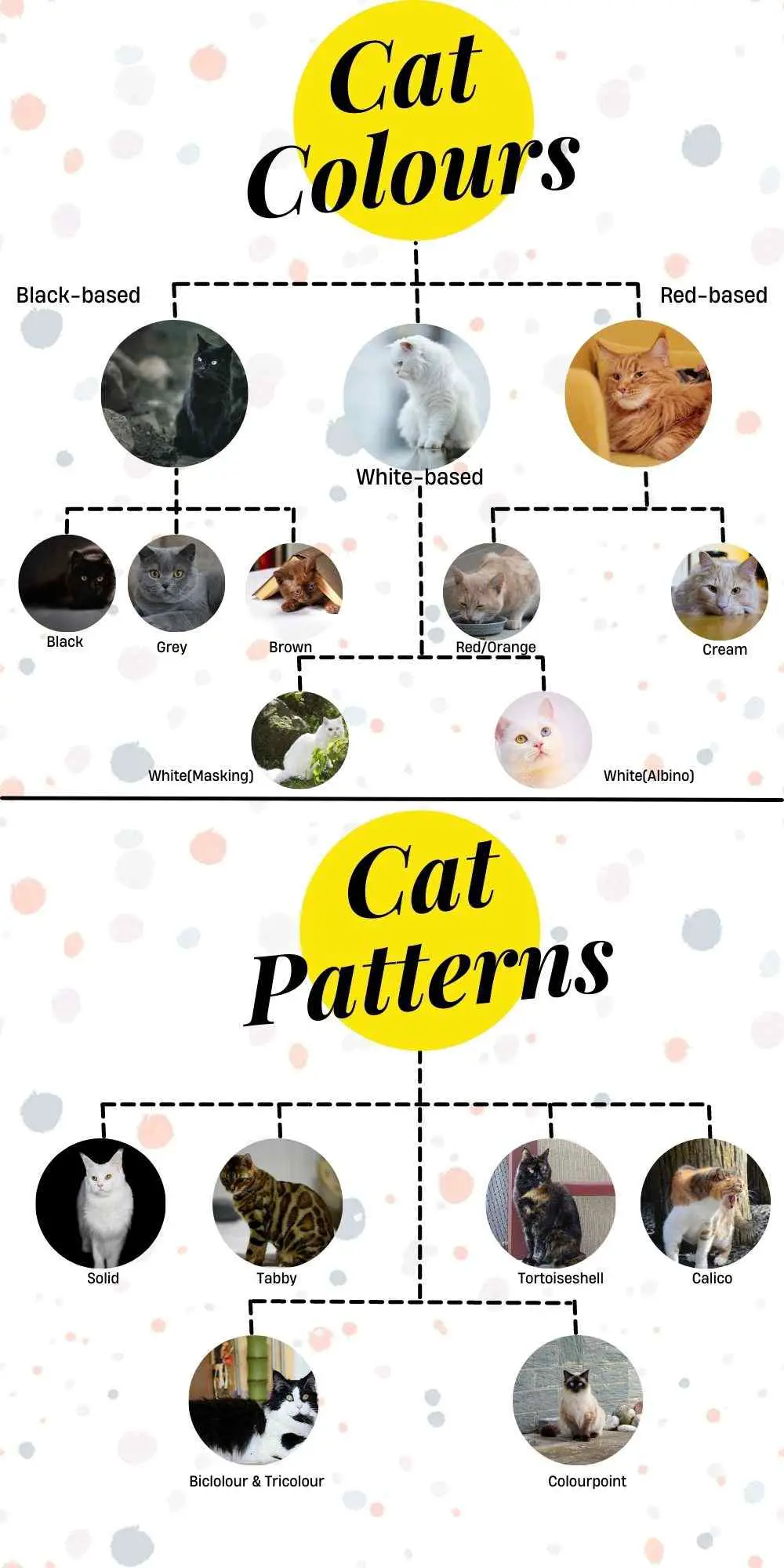
How Colours and Patterns are Formed(The Boring Concept of Genetics)?
Cat colours and patterns are determined by the ‘X’ chromosome in cats. The ‘X’ chromosome is the very chromosome that determines the sex of a cat. Recall, you have studied in the Biology class, the combination of ‘XY’ chromosomes produces a male while that of ‘XX’ chromosome makes a female.
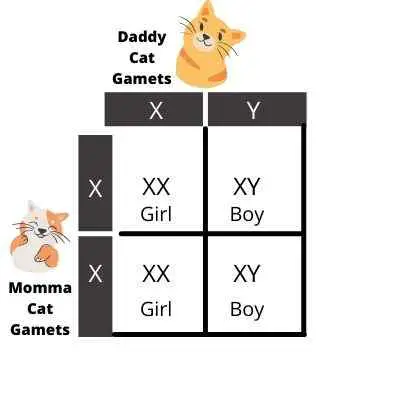
Basically, cats are black unless they have received a sex-linked orange masking gene that is being carried by the same ‘X’ chromosome. Thus, during embryo development, the colouring genes come into action and give cats different colours and a myriad of patterns.
Here’s a twist. Male cats can only be black or red. Why? You see, males are XY so they have just one ‘X’ chromosome to get red. When the red gene dominates over the black we get a red(orange) tom. On the contrary, when the black gene dominates over the red we get a black male cat.
You may object here, “But, I have seen brown, grey, chocolate, creme male cats too?” Yes, you are right this happens because of the other modifying factors(technically known as polygenes) that dilute the red or black gene and we get lighter colours such as grey, creme, brown and their numerous shades.
Female cats, on the other hand, can show more colours than males. Also, they can have two or three colours in their coats. So, you may see a female cat having a bicolour (think of a tuxedo cat) or tricolour(think of a calico cat) coat. Similarly, female cats can also show patterns like tortoiseshell, calico, tortoiseshell and white.
So, let’s list down how many kinds of colours and patterns cats can have.
1. Cats Have 6 Coat Colours These Are:
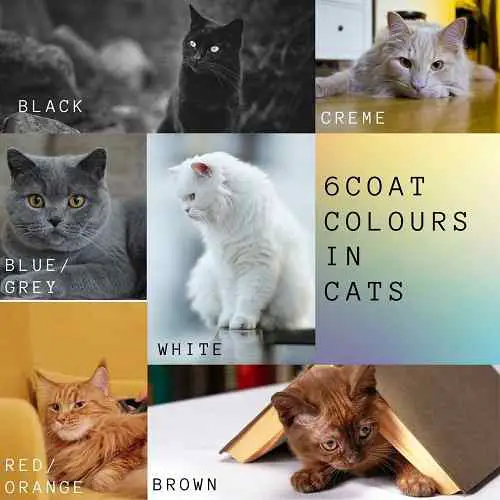
- White
- Black
- Blue/Grey
- Brown
- Red/Orange
- Cream
Note* Technically cats have just 5 colours of coats black, blue, grey, brown, red and cream. And white is not a colour it is the result of either masking or albinism.
2. Cats have 6 Basic Varieties of Patterns
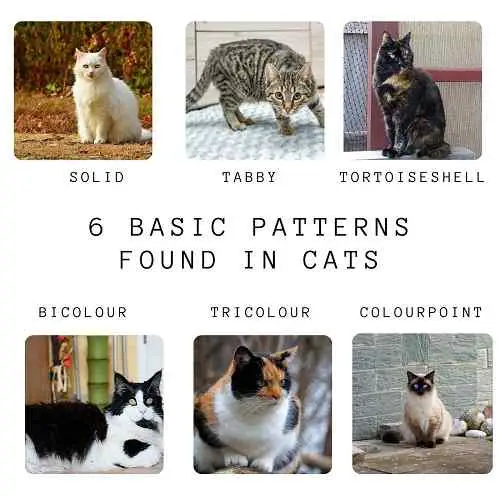
- Solid
- Tabby
- Tortoiseshell
- Bi-colour
- Tricolour
- Colourpoint
Now that we have seen the basic colours and patterns of cats’ coats. It’s time to stretch out the topic a bit and discuss each of the above-mentioned points in detail. Let’s start with colours first.
Related: The Black Persian Cat
6 Coat Colours in Cats
#1. White Coat (Or It’s Better to Say White Looking Coat)
Undoubtedly, white cats look gorgeous. Breeds like Persian, American Shorthair, Turkish Angora, Maine Coon and others can show glittering white coats. Remember, white cats, calico cats, and tortoiseshell cats are not breeds; these are the names of patterns.
“But, I said, “Cats can have either black or red genes”. So, how come they get a white coat when there’s either red or black gene?
All right, I got you. Look, cats can look white due to two genetic conditions which are technically known as masking and albinism.
I) The First Case: Masking
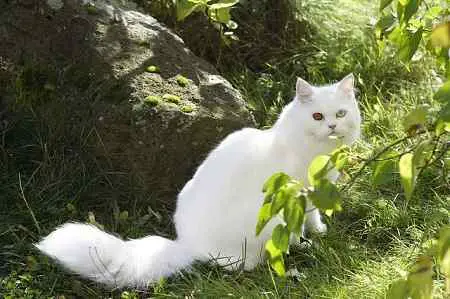
Actually, the white colour is the result of the white masking gene (‘W’ gene) also known as the Dominant White (DW) gene. During the transfer of genes from parents to the offspring the white gene rides over the other gene and sometimes masks the other colours in cats.
There can be three kinds of genes responsible for colouring these are- N- normal or non-white gene, Ws- white spotting gene, DW- dominant white gene
i) N/N Genotype
The NN genotype is a normal combination. These cats cannot be white nor their offspring can be.
ii) N/DW Genotype
The cats will be white because the Dominant White (DW) gene dominates over the N gene and gives the cat a white appearance. The cats may have weak hearing too.
iii) DW/DW Genotype
Since this genotype has both genes as DW, these cats can only be white and all of their offspring will be white.
iv) N/Ws Genotype
These cats will show white spotting. You must have seen bicolour and tricolour cats, haven’t you? Also, half of their offspring will have white while the other half will have normal colours.
v) Ws/Ws Genotype
Again, since both of the genes in this genotype are ‘Ws’. So, these cats will have white spotting and 100% of their offspring will have white spotting too.
v) Ws/DW Genotype
As you can see, this type of genotype includes Dominant White (DW) so this DW gene will dominate the White Spotting (Ws) gene and the cat will be white. Also, 50% of their offspring will be white and 50% will show white spotting.
II) The Second Case: Albinism
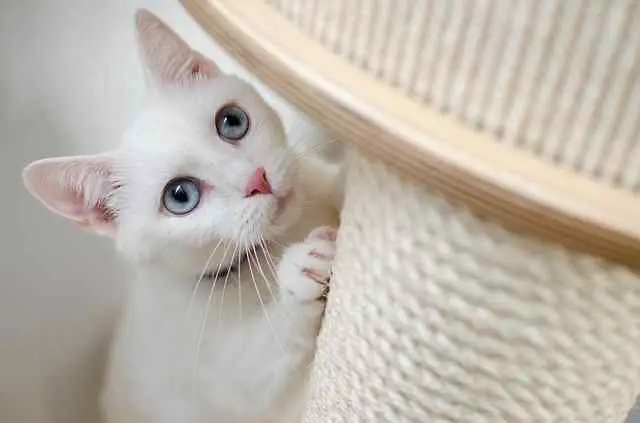
You may not differentiate between cats that have white coats due to masking and albino cats. Albino cats have light pinkish-white coats with blue or red eyes. They get this colour due to the absence of an enzyme called Tyrosinase which produces ‘Melanin’. Know that melanin is the pigment that determines the colour of cats’ coats, skin and eyes.
So, albino cats may transfer two kinds of alleles- albino allele denoted by A, and normal allele N. Now there can be the following possible cases:
i) N/N Genotype
Such cats will not be albino nor their offspring will be.
ii) N/A Genotype
Thes cat will not be albino because the Normal gene(N gene) will dominate over the Albino gene(A gene) and the resulting cat will have a normal colour coat. However, they can still transfer the albino allele to the offspring.
iii) A/A Genotype
As visible, this kind of genotype has both alleles as Albino(A). So, 100% of such cats will be albino and transfer the albino allele to all of their offspring too.
2. Black-Based Colours
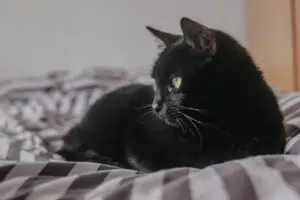
The second type of cat colour is black-based colours. These coat colours are the result of Dominant Black(B) or Recessive Black(b)genes. Now there are three black-based colours produced by black genes, there:
I) Black Coat
Cats will have a solid black colour when they have a dominant Black Gene(B) and as well as a non-agouti (a) gene. If a cat would have a dominant agouti gene then she will have a tabby pattern instead of solid black.
Another interesting fact is, some black cats may have a tabby pattern but they look solid black because the dominant black gene represses the non-agouti gene. Their tabby pattern can be observable only when you look at their coat closely in the sunlight.
All-black coats are more common in male cats as compared to females. Black cats can be of both breed or non-breed mixed ancestry. When it comes to breeds all-black coats can be seen in Persian, Maine Coon, Bombay, American Bobtail and seventeen other breeds.
Black cats often have golden eyes due to the excess of pigmentation by melanin. There is a myth that has existed for a long time and many people still believe that black cats have some kind of association with witches. However, it’s just a myth. Don’t believe in that crap.
Surprisingly, the black colour can fade or rust over time in some cats. Black cats that spend most of their time in the sunlight may experience rusting of their coats and it sometimes acquires a brown shade.
II) Blue(Grey) Coat
We commonly call this grey coat. But experts, breeders and formal organisations call it a blue coat. Bluecoat is the result of the dilution of the Dominant Black gene. However, dilution doesn’t mean that there is a lack of melanin production in such cats. In fact, the melanin synthesis is normal, its pigment granules are normal which tend to deposit unevenly and we get a resultant lighter coat.
To understand the concept properly let’s have a look at what the cat can have either Dominant gene always another by UPPERCASE such as B(black) or R(for Red) genes, or a recessive gene always denoted by LOWERCASE such as d or d.
The dilute genes are recessive. In simple words, cats must possess two copies of recessive genes to show dilution(lighter shades of black and red) otherwise the Dominant gene will rule and the cat will have a darker colour either red or black.
Now there can be the following three cases:
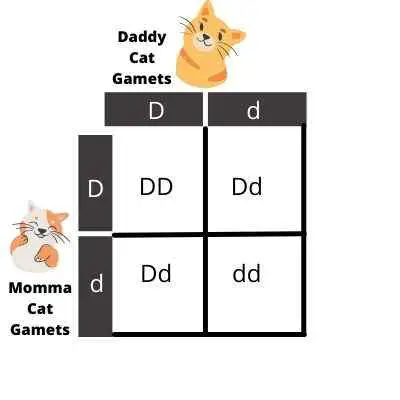
i.) D/D Genotype
Clearly, in this scenario, the cats will have dark colour since both of the alleles are dominant.
ii) d/d Genotype
Cats that are d/d will show dilute colours. In this case, they will be grey/blue since here we are not talking about colours formed by the Red gene.
iii) D/d Genotype
Cats with D/d will also show dark colours because the Dominant(D) gen will suppress the recessive (d).
Some cat breeds that can be can fully grey coats are Chartreux, BritishShorthair, Korat, Persian, Maine Coon, Oriental cat and more.
III) Brown Coat
Brown and its shades are also the variant of black in cats. The Veterinary Genetics Laboratory explains that a gene known as tyrosinase-related-protein-1(TYRP-1) is responsible for production and mutation in the black pigment(eumelanin) causing it to turn into brown. There are two variants that exist of the Dominant B, b and b’.
Both of these variants of the Dominant B gene are recessive and give different shades of brown to cats.
i) b recessive genes produce a darker shade of brown which we commonly call chocolate or chestnut.
ii) b’ recessive gene produces a lighter shade of brown known as Cinnamon.
Some cat breeds that can have brown colours are Havana Brown, Burmese, York Chocolate, Persian, Maine Coon etc.
3. Red Based Colour
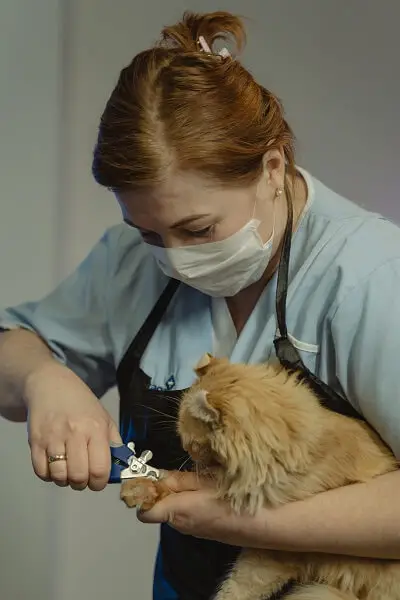
I) Red Coat
The Red gene denoted by ‘O’ is carried by the sex-linked ‘X’ gene. Red gene(O) is dominant to Black gene(B). So, if a cat possesses both dominant red and black genes he will be Red. That’s why red cats are generally male because males are XY. Male orange cats get the orange gene from their mother and this dominates over the black gene and they become red. In the absence of the red (O) gene, cats remain black.
On the other hand, females are red. To have a red coat a female cat must possess 2 “O” genes which is a rare case. Therefore, they usually get patterns such as calico and tortoiseshell.
I) Cream Coat: A Variation of Red
Lastly, the cream is a variation of red(O). When a dominant red gene gets diluted due to the presence of 2 recessive(dd) red genes we get cats with cream coats.
You May Like to Read: White Cats with Blue Eyes
6 Basic Patterns in Cats
1. Solid
The first pattern is of course solid about what we have already discussed in the previous section so there’s no need to discuss that again.
2. Tabby
Tabby is the most common pattern found in both domestic and wild cats. You may see tabby cats everywhere on the road, in the park, at the bus stops, in homes and in cat shelters. Because there are so many in number. Cheetah, leopard, tiger, jaguar all show some kind of tabby pattern or the other.
The tabby pattern is characterised by a typical ‘M’ shaped marking at the forehead; black stripes starting from the eyes that go towards the back of the head; the similar stripes on the cheeks. The tabby cats also have banded, swirled, or flecked patterns on the back, abdomen, tail, limbs and chest.
Cats that show tabby patterns must have a dominant or recessive agouti gene. Interestingly, solid colour cats can also show the tabby pattern which can be identified by looking at the ‘M’ shaped mark on their forehead.
The 4 major varieties of tabby patterns are:
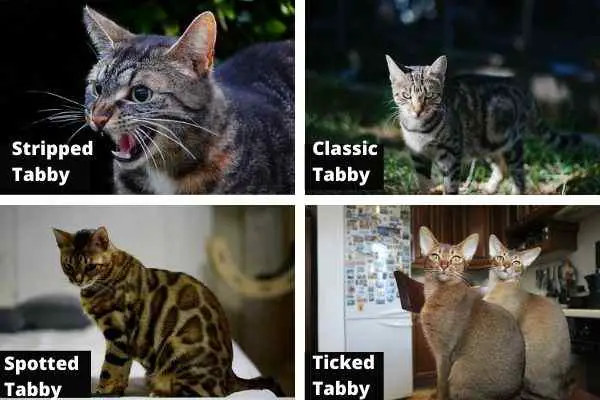
i) Striped/Mackerel Tabby
ii) Classic/Blotched or Marbled Tabby
iii) Ticked/Agouti Tabby
iv) Spotted Tabby
I) Mackerel Tabby
Mackerel or Striped tabby, also known as ‘fishbone tabby’ is the most common variety of tabby patterns. This pattern can be commonly seen both in non-breed and pedigree cats. You can clearly see dark lines making an ‘M’ pattern at the forehead almost on all mackerel tabbies.
These cats also have slightly curved and dark lines around the eyes that go to the cheeks. Also, they have thin and gently curved stripes that may be continuous or broken along the back, limbs, and tail. You may observe a dark line and symmetrical line on their spine extending from the shoulder to the tail.
II) Classic or Blotched Tabby
Classic or Blotched tabby is also known as marbled tabby because of the marble-like pattern of its coat. These cats have a distinctive bull’s eye mark on either side of their bodies. Their entire bodies have dark coloured stripes, spots and blotches which give them a fascinating pattern.
Like other tabbies, the classic tabby also has their signature ‘M’ mark on the forehead and horizontal lines on their cheeks. Unlike mackerel tabbies, the bands and stripes of classic tabbies are pretty broad and broken.
All classic tabbies have a butterfly pattern on their shoulders. They also have three thick stripes along the spine that go almost parallel to each other starting from the shoulder to the tail.
III) Ticked Tabby
Ticked tabbies look like solid-coloured cats at a first glance. However, when you look closely you find that the cats don’t have solid coats but tabby patterns. Unlike the other tabby cats, ticked tabbies don’t have stripes, blotches, spots on their body have a pattern on the individual hair. They have a dark colour band on the individual hair with light colour at the base. This gives them a shimmering, dotted and sandy appearance.
A common characteristic that ticked tabby shares with other tabby cats is the ‘M’ marking on the forehead and the standard dark line along the spine. Some tabby cats also have curved lines, bands or bars on the limbs and tail. Abyssinian is the most common breed that has a ticked tabby pattern.
IV) Spotted Tabby
The spotted tabby pattern is more common in wild cats (cheetah, leopard, jaguar, serval and more) than domestic cats. The shape, size and density of these spots vary even in wild cats.
Bengal is the most famous breed that shows this pattern due to its genetic linkage with leopards. Egyptian Mau, Arabian Mau, Savannah, are some among the other cats that have a spotted tabby pattern.
It is believed that the modifier gene bears up the mackerel tabby giving it a spotted tabby pattern, while the spotted tabby gene breaks the classic tabby pattern and changes it to large spots. All spotted tabby cats have the standard ‘M’ mark on their forehead.
3) Tortoiseshell
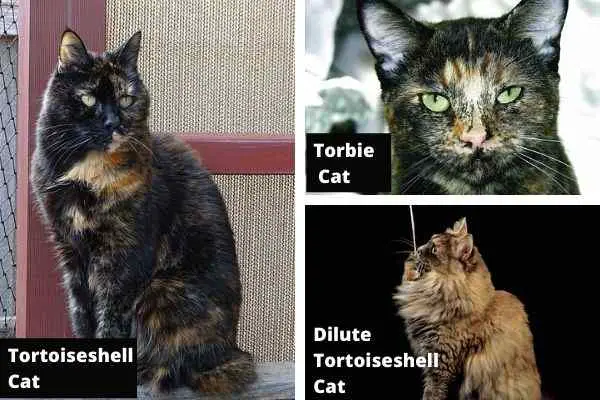
No matter whether you call her a tortoiseshell or tortie.
Tortoiseshell is bicolour cats having black and colour patches. The ratio of orange and black patches greatly varies from cat to cat.
Recall that female cats can rarely have solid orange coats because they are ‘XX’ and need to have 2 Red genes to be fully red. So, when they receive just 1 red gene they become tortoiseshell or calico. Hence, these are female cats.
Some breeds that can commonly be spotted having a tortoiseshell pattern are Persian, Maine Coon, British Shorthair, Cornish Rex, American Shorthair and more.
II) Torbie
Sometimes a Tortoiseshell can have any of the above-mentioned tabby patterns along with red(orange) patches. This cat is known as a torbie.
II) Dilute Tortoiseshell
This is another variant of tortoiseshell cats. When a cat instead of receiving the dominant red(O) and black(B) genes receive the recessive genes it gets grey and cream patches instead of orange and red.
4) Bicolour and Tricolour
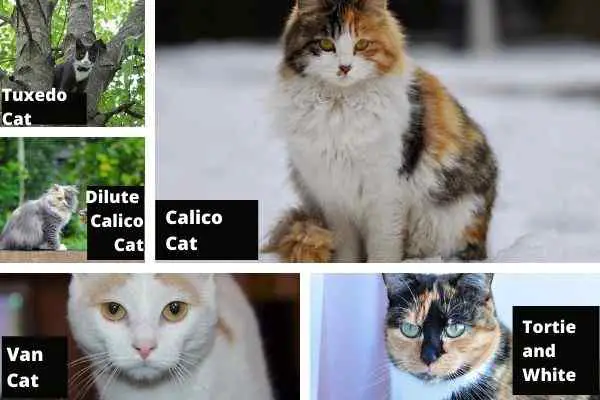
As the name suggests these cats have bicolour or tricolour coats. Bicolour cats are known as piebald cats. Their colour combinations can include white and black(tuxedo cat), grey and white(dilute tuxedo), and red and white(van).
On the other hand, tricolour cats have either three colours or white with tabby or tortoiseshell patterns. Their coats can have colours—red, black and white(calico), grey, creme and white (dilute calico), tabby and white or tortoiseshell and white.
I) Tuxedo
The contrasting pattern of white and black gives tuxedo cats an appealing appearance. They are named after a men’s formal wear black suit with white tie known as ‘tuxedo’ in the U.S. and Canada. Because cats having this pattern look as if they are wearing a white tie on their black coat.
Technically, any combination of white and black can be called tuxedos but some give distinctive names to each pattern based on the ratio between black and white patches. Normally, a tuxedo cat has a black coat with white patches on the face and chest along with white paws.
Tuxedo cats with the recessive ‘d’ gene have grey coats instead of black and they are called dilute-tuxedos.
II) Van
Turkish Van is a breed that originated in Turkey that exhibits van patterns. In fact, the pattern is named after this cat because it’s a pattern peculiar to this breed only.
Being bicolour this pattern exhibit two colours. But unlike tuxedos, here we have red instead of black. Also in pattern, the entire body has a white coat with patches of red on the head and tail which is due to the piebald White Spotting gene (Ws) which we have discussed above.
III) Calico
99.9% of Calico cats are females. Male calico cats are extremely rare under very unique genetic conditions and they are more vulnerable to diseases. The pattern is known with different names around the world such as charge(in France) and mike’neko(in Japan).
The calico pattern is composed of three colours white, black and red. The more dominant colour is white with patches of black and red at different parts of the body. This is a vibrant and very attractive pattern that catches anybody’s attention the first glance. To know more about calico cats visit this link.
IV) Dilute Calico
The only difference between a calico and a dilute calico pattern is in dilute calico the red is diluted to cream and black dilutes to grey(blue). Because of the recessive black and red genes.
V) Tortoiseshell and White & Tabby & White
The last possibility when a cat can show tricolour is when a tortoiseshell is all & white or tabby & white patterns. These cats have some patches of the white coat along with either tortoiseshell or tabby patterns.
5. Colour Point
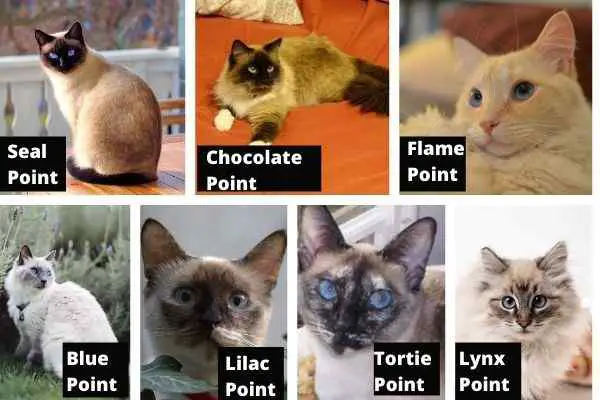
Next, we have a point pattern. The point pattern is characterised by lighter shade bodies with a much darker colour at the extremes such as the face, tail, ears and lower legs. The colourpoint pattern is the result of the mutation in tyrosinase which is an enzyme that produces melanin.
The colourpoint gene is temperature-sensitive which keeps the colour restricted to the low-temperature extremities of a cat’s body. Basically, this kind of pattern is a form of albinism which is called ‘partial albinism’. Also, to have a pointed pattern the kitten must receive a 2-genes one from each parent.
There are seven varieties of colourpoint patterns found, these are- seal point, chocolate point, flame point, blue point, lilac point, tortie point and lynx point.
The famous breeds that exhibit colourpoint patterns are the Ragdoll, Birman, Himalayan and of course the Siamese cat.
I) Seal Point
The sear point pattern is typically seen in a classical Siamese cat. They have a lighter colour does with very dark colour patches on the extremists.
II) Chocolate Point
The chocolate point is a lighter variant of seal points. In the chocolate point cats, the shade on the point pattern is a bit lighter than the seal point.
III) Flame Point Siamese
Next, and the more subtle variant is the flame point. Here, the points become even lighter and the brown colour looks like an orange flame that’s why cats with this pattern are known as flame points.
IV) Blue Point
In blue point cats, the colour of extremities is blue(grey) instead of brown. This happens because of the dilution of the dominant black gene.
V) Lilac Point
When the blue colouring gets further diluted we get lilac point cats. These cats have very light cloudy colouring on their faces, tails and sometimes on their legs.
VI) Tortie Point
This is a very interesting pattern where we get a tortie pattern at the extremities. Thus we have both tortoiseshell and point patterns in the same cats.
VII) Lynx Point
In the lynx point pattern, the cats will have a striped pattern instead of on tortoiseshell but only on their face, tails, ears and legs with lighter bodies. You get the typical ‘M’ mark on their face.
The Colourful Conclusion
Ok. That was my take on colours. If you have reached here it proves that you are deeply in love with cats and want to learn more about them. In this post, I tried to put the complex genetics of colours in the simplest way I can. By now, you know all the major colours and patterns found in domestic cats. I hope that now you won’t get confused in identifying a cat’s colours. This guide will also help you to estimate the average price of a cat since the prices of cats vary a lot with colour too.
Lastly, if you liked the post then a good way to appreciate my efforts is to leave a comment and share in your social groups so that the other cat lovers who are new to the cat world(like you) can benefit from this guide. Thanks for Reding.
“So Which Colour or Pattern You Liked the Most?”
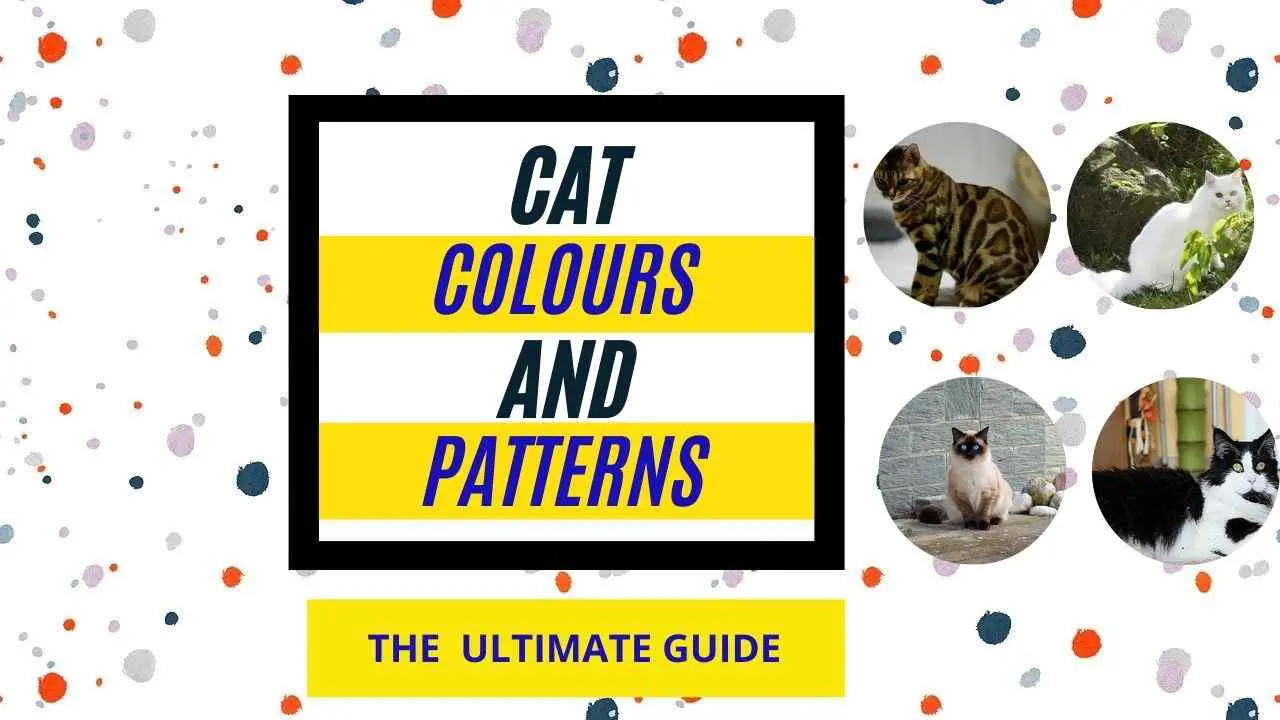

Nothing to add, just I love to spend time in this website and read every word here.
I this like as well:
It is a pleasure to hear such words. We will try to make the next articles even better.
I cannot believe that there are people that think alike me. So good that I found this website.
We are thankful to you that you liked our content. Hope that you keep supporting us. Cheers!